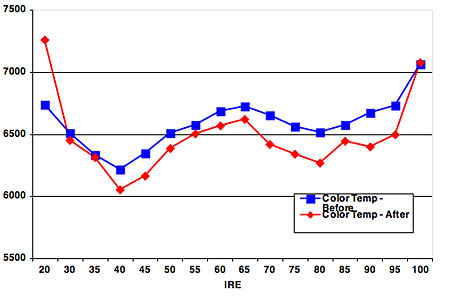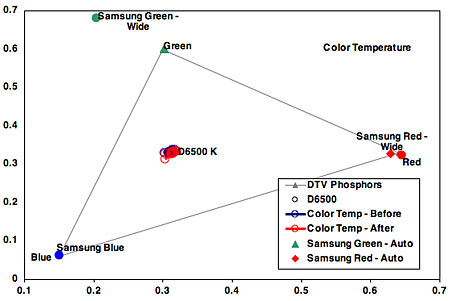LCDs From Sony, Samsung, Toshiba & Philips HT Labs Measures: Samsung


Full-On/Full-Off Contrast Ratio—5,262:1; ANSI Contrast Ratio—1,413:1
Measured Resolution with the Leader LT-446:
480: 480 (per picture height)
720p: 720 (pph)
1080i: 1,080 (pph)
DC Restoration (poor, average, good, excellent): Excellent
Color Decoder (poor, average, good, excellent): Excellent (Wide), Good (Auto)
Measured Color Points (Wide):
Red Color Point: x=0.645, y=0.324
Green Color Point: x=0.204, y=0.682
Blue Color Point: x=0.150, y=0.063
Measured Color Points (Auto):
Red Color Point: x=0.629, y=0.327
Green Color Point: x=0.302, y=0.602
Blue Color Point: x=0.150, y=0.063
The top chart shows the LN-T5271F's gray scale relative to its color temperature at various levels of intensity, or brightness (20 IRE is dark gray; 100 IRE is bright white). The gray scale as set by the factory, in the Warm2 color-temperature mode and the Movie picture mode, measures cool with dark images, warm with lower midtones, and cool with midtones, then cooler still with brighter images. After making adjustments using the Photo Research PR-650, the gray scale measures hardly better. The "before" measurement is somewhat suspect, as this unit may have been calibrated before arrival at our lab.
The bottom chart shows the gray scale (or color temperature) relative to the color points of the display's red, green, and blue color filters. In the Wide mode, these are somewhat off those specified by SMPTE. Red is very slightly oversaturated, green is very oversaturated and very bluish-green. Blue is pretty much spot on. In the Auto mode, red becomes slightly undersaturated, blue stays the same, and green becomes much more accurate and is pretty much spot on.
After calibration, and using a full-field 100-IRE white (63.14 foot-lamberts) and a full-field 0-IRE black (0.012 ft-L), the contrast ratio was 5,262:1. Using a 16-box checkerboard pattern (ANSI contrast), the contrast ratio was 1,413:1. Most LCDs have nearly identical ANSI and full-on/full-off contrast ratios, so this number is more accurate to the contrast ratio that this panel is actually creating. The best contrast ratio was achieved with the Energy Saving mode set to Auto and the backlight set to 10. In this mode, the LN-T5271F is riding the video signal with its backlight, so this number is artificially inflated (much like an auto-iris on a projector). The best black level was produced with the Energy Saving mode set to Off and the backlight set to 0. In this mode, the LN-T5271F produced 20.39 ft-L and 0.010 ft-L for a contrast ratio of 2,039:1. The brightest image was achieved with the Energy Saving mode set to Off and the backlight set to 10. In this mode, the LN-T5271F produced 145.6 ft-L and 0.082 ft-L for a contrast ratio of 1,776:1.—GM




























































